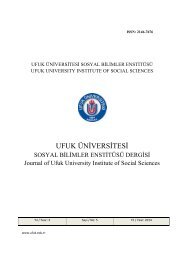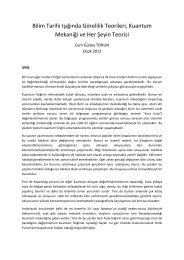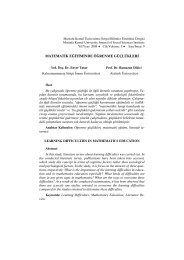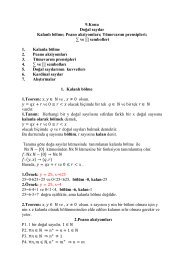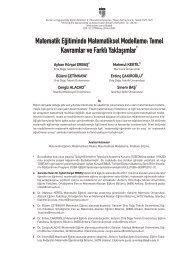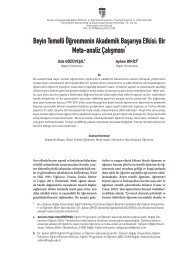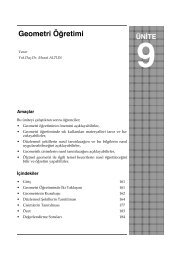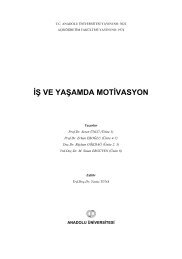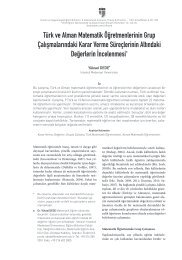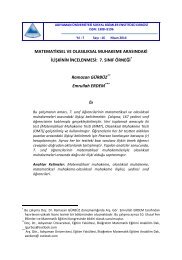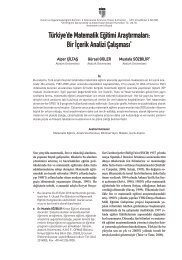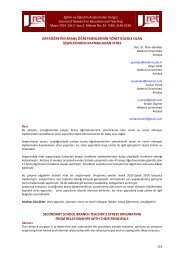NEWSLETTER
2015-12-98
2015-12-98
You also want an ePaper? Increase the reach of your titles
YUMPU automatically turns print PDFs into web optimized ePapers that Google loves.
Feature<br />
Partial support from NSF grant number DMS-1501094 is also<br />
gratefully acknowledged.<br />
2 Main Results<br />
We now explain the classical Hermitian eigenvalue problem<br />
and its generalisation to an arbitrary connected semisimple<br />
group more precisely.<br />
For any n×n Hermitian matrix A, let λ A = (λ 1 ≥···≥λ n )<br />
be its set of eigenvalues written in descending order. Recall<br />
the following classical problem, known as the Hermitian<br />
eigenvalue problem. Given two n-tuples of nonincreasing real<br />
numbers: λ = (λ 1 ≥ ··· ≥ λ n ) and µ = (µ 1 ≥ ··· ≥ µ n ),<br />
determine all possible ν = (ν 1 ≥ ··· ≥ ν n ) such that there<br />
exist Hermitian matrices A, B, C with λ A = λ, λ B = µ, λ C = ν<br />
and C = A + B. This problem has a long history, starting<br />
with the work of Weyl (1912), followed by works of Fan<br />
(1949), Lidskii (1950) and Wielandt (1955), and culminating<br />
in the following conjecture given by Horn (1962). (See also<br />
Thompson-Freede (1971).)<br />
For any positive integer r < n, inductively define the set<br />
S n r as the set of triples (I, J, K) of subsets of [n] := {1,...,n}<br />
of cardinality r such that<br />
∑ ∑<br />
∑<br />
i + j = r(r + 1)/2 + k (1)<br />
i∈I<br />
j∈J<br />
and, for all 0 < p < r and (F, G, H) ∈ S r p , the following<br />
inequality holds:<br />
∑ ∑<br />
∑<br />
i f + j g ≤ p(p + 1)/2 + k h . (2)<br />
f ∈F<br />
g∈G<br />
Conjecture 1. A triple λ,µ,ν occurs as eigenvalues of Hermitian<br />
n × n matrices A, B, C respectively such that C = A + B<br />
if and only if<br />
n∑ n∑ n∑<br />
ν i = λ i +<br />
i=1<br />
i=1<br />
µ i<br />
i=1<br />
k∈K<br />
h∈H<br />
and, for all 1 ≤ r < n and all triples (I, J, K) ∈ S n r , we have<br />
∑ ∑ ∑<br />
ν k ≤ λ i + µ j .<br />
k∈K<br />
i∈I<br />
Horn’s conjecture above was settled in the affirmative<br />
(see Corollary 11) by combining the work of Klyachko [Kly]<br />
(1998) with the work of Knutson-Tao [KT] (1999) on the ‘saturation’<br />
problem.<br />
The above system of inequalities is overdetermined. Belkale<br />
(2001) proved that a certain subset of the set of inequalities<br />
suffices. Subsequently, Knutson-Tao-Woodward (2004)<br />
proved that the subsystem of inequalities given by Belkale<br />
forms an irredundant system of inequalities.<br />
Now, we discuss a generalisation of the above Hermitian<br />
eigenvalue problem (which can be rephrased in terms of the<br />
special unitary group SU(n) and its complexified Lie algebra<br />
sl(n)) to an arbitrary complex semisimple group. Let G<br />
be a connected, semisimple complex algebraic group. We fix<br />
a Borel subgroup B, a maximal torus H ⊂ B and a maximal<br />
compact subgroup K. We denote their Lie algebras by<br />
the corresponding Gothic characters: g, b, h, k respectively. We<br />
choose K such that √ −1 k ⊃ h. Let R + be the set of positive<br />
roots (i.e. the set of roots of b) and let ∆={α 1 ,...,α l }⊂R +<br />
be the set of simple roots. There is a natural homeomorphism<br />
j∈J<br />
δ : k/K → h + , where K acts on k by the adjoint representation<br />
and h + := {h ∈ h : α i (h) ≥ 0 ∀ i} is the positive Weyl chamber<br />
in h. The inverse map δ −1 takes any h ∈ h + to the K-conjugacy<br />
class of √ −1h.<br />
For any positive integer s, define the eigencone<br />
s∑<br />
¯Γ s (g) :={(h 1 ,...,h s ) ∈ h+ s |∃(k 1,...,k s ) ∈ k s :<br />
= 0 and δ(k j ) = h j ∀ j}.<br />
k j<br />
j=1<br />
By virtue of the general convexity result in symplectic geometry,<br />
the subset ¯Γ s (g) ⊂ h+ s is a convex rational polyhedral cone<br />
(defined by certain inequalities with rational coefficients). The<br />
aim of the general additive eigenvalue problem is to find the<br />
inequalities describing ¯Γ s (g) explicitly. (The case g = sl(n)<br />
and s = 3 gives the Hermitian eigenvalue problem if we replace<br />
C by −C.)<br />
Let Λ=Λ(H) denote the character group of H and let<br />
Λ + := {λ ∈ Λ : λ(α ∨ i ) ≥ 0 ∀ simple coroots α∨ i<br />
} denote the<br />
set of all the dominant characters. Then, the set of isomorphism<br />
classes of irreducible (finite dimensional) representations<br />
of G is parametrised by Λ + via the highest weights of<br />
irreducible representations. For λ ∈ Λ + , we denote by [λ] the<br />
corresponding irreducible representation (of highest weight<br />
λ).<br />
Similar to the eigencone ¯Γ s (g), one defines the saturated<br />
tensor semigroup:<br />
Γ s (G) ={(λ 1 ,...,λ s ) ∈ Λ+ s : ([Nλ 1] ⊗···⊗[Nλ s ]) G<br />
0, for some N ≥ 1}.<br />
Then, under the identification ϕ : h ∼ −→ h ∗ (via the Killing<br />
form),<br />
ϕ(Γ s (g)) ∩ Λ s + =Γ s (G) (3)<br />
(see Theorem 5).<br />
For any 1 ≤ j ≤ l, define the element x j ∈ h by<br />
α i (x j ) = δ i, j , ∀ 1 ≤ i ≤ l. (4)<br />
Let P ⊃ B be a standard parabolic subgroup with Lie algebra<br />
p and let l be its unique Levi component containing the<br />
Cartan subalgebra h. Let ∆(P) ⊂ ∆ be the set of simple roots<br />
contained in the set of roots of l. Let W P be the Weyl group of<br />
P (which is, by definition, the Weyl Group of the Levi component<br />
L) and let W P be the set of the minimal length representatives<br />
in the cosets of W/W P . For any w ∈ W P , define the<br />
Schubert variety:<br />
X P w<br />
:= BwP/P ⊂ G/P.<br />
It is an irreducible (projective) subvariety of G/P of dimension<br />
l(w). Let µ(Xw P) denote the fundamental class of XP w , considered<br />
as an element of the singular homology with integral<br />
coefficients H 2l(w) (G/P, Z) of G/P. Then, from the Bruhat<br />
decomposition, the elements {µ(Xw P)} w∈W P form a Z-basis of<br />
H ∗ (G/P, Z). Let {[Xw]} P w∈W P be the Poincaré dual basis of the<br />
singular cohomology H ∗ (G/P, Z). Thus,<br />
[X P w] ∈ H 2(dim G/P−l(w)) (G/P, Z).<br />
Write the standard cup product in H ∗ (G/P, Z) in the {[Xw P]}<br />
basis as follows:<br />
∑<br />
[Xu P ] · [XP v ] = c w u,v [XP w ]. (5)<br />
w∈W P<br />
EMS Newsletter December 2015 21




